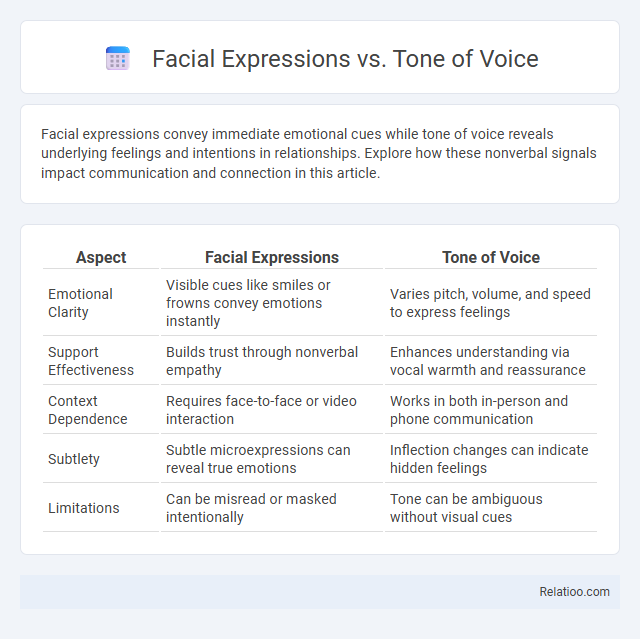Facial expressions convey immediate emotional cues while tone of voice reveals underlying feelings and intentions in relationships. Explore how these nonverbal signals impact communication and connection in this article.
Table of Comparison
| Aspect | Facial Expressions | Tone of Voice |
|---|---|---|
| Emotional Clarity | Visible cues like smiles or frowns convey emotions instantly | Varies pitch, volume, and speed to express feelings |
| Support Effectiveness | Builds trust through nonverbal empathy | Enhances understanding via vocal warmth and reassurance |
| Context Dependence | Requires face-to-face or video interaction | Works in both in-person and phone communication |
| Subtlety | Subtle microexpressions can reveal true emotions | Inflection changes can indicate hidden feelings |
| Limitations | Can be misread or masked intentionally | Tone can be ambiguous without visual cues |
Understanding Facial Expressions: A Primary Mode of Communication
Facial expressions serve as a primary mode of communication by conveying emotions such as happiness, anger, and surprise instantaneously and universally across cultures. Unlike tone of voice or other nonverbal cues, your facial expressions provide direct insight into true feelings, often revealing what words cannot express. Mastering the interpretation of these subtle movements enhances your ability to accurately read and respond to others in social and professional interactions.
The Power of Tone of Voice in Conveying Emotions
Tone of voice plays a crucial role in conveying emotions, often revealing true feelings behind words more effectively than facial expressions or other nonverbal communication. Subtle variations in pitch, volume, and rhythm can express anger, joy, sadness, or sarcasm, impacting how messages are interpreted. Studies show that up to 38% of emotional meaning in communication is transmitted through vocal tone, underscoring its power in interpersonal interactions.
Facial Expressions vs Tone of Voice: Key Differences
Facial expressions convey emotions through visual cues like smiles, frowns, and eye movements, providing immediate, often universal signals that enhance understanding. Tone of voice reflects emotional nuances and intentions through pitch, volume, and rhythm, influencing how your message is perceived beyond the words spoken. Together, these elements shape nonverbal communication by complementing or contrasting verbal content, but facial expressions offer more direct insight into genuine feelings compared to vocal tone.
Psychological Impact of Facial Expressions
Facial expressions play a critical role in psychological communication by conveying emotions directly linked to individual mental states, often triggering empathetic responses and influencing social interactions more profoundly than tone of voice or other nonverbal cues. Research in psychology demonstrates that specific facial expressions, such as smiling or frowning, activate mirror neurons in the brain, enhancing emotional understanding and social bonding. These expressions serve as immediate, universal signals that shape perceptions, regulate interpersonal dynamics, and affect emotional well-being.
How Tone of Voice Influences Interpersonal Communication
Tone of voice significantly shapes interpersonal communication by conveying emotions and attitudes beyond words, impacting how messages are received and interpreted. Variations in pitch, volume, and rhythm signal confidence, empathy, or hostility, influencing rapport and trust between individuals. Effective use of tone can enhance clarity and emotional connection, while mismatched tone and content often lead to misunderstandings and conflict.
Cultural Variations in Interpreting Facial Expressions and Tone
Cultural variations significantly influence the interpretation of facial expressions and tone of voice, with some emotions displayed openly in certain cultures but subtly or differently expressed in others. Your ability to accurately understand these nonverbal cues depends on recognizing that a smile or vocal warmth might signal friendliness in one culture but convey discomfort or sarcasm in another. Mastering these nuances ensures more effective cross-cultural communication and reduces misunderstandings.
Nonverbal Cues: When Expressions and Tone Contradict
Nonverbal communication plays a crucial role when facial expressions and tone of voice send conflicting signals, as your subconscious often trusts body language over spoken words. Microexpressions, gestures, and posture provide valuable context that helps decipher true emotions, aiding you in detecting deception or mixed feelings. Understanding these subtle nonverbal cues enhances your ability to interpret others accurately, improving communication effectiveness.
Enhancing Communication: Integrating Facial Expressions and Tone
Enhancing communication involves integrating facial expressions and tone of voice to convey emotions and intentions more effectively, creating a richer interaction experience. Your facial expressions provide visual cues that complement the emotional quality carried by your tone, allowing others to better interpret your message. Combining these nonverbal elements strengthens understanding and builds trust, improving overall interpersonal connections.
Common Misinterpretations in Facial Expressions and Tone of Voice
Common misinterpretations in facial expressions often arise because subtle nuances like microexpressions or cultural differences can lead to incorrect assumptions about emotions, such as mistaking a neutral face for anger. Tone of voice can also be misleading, as variations in pitch, volume, or pace might be incorrectly interpreted as sarcasm, hostility, or disinterest without considering context. Your awareness of these potential misunderstandings helps improve communication by prompting you to seek clarification beyond immediate nonverbal cues.
Practical Tips for Mastering Nonverbal Communication
Mastering nonverbal communication requires keen awareness of your facial expressions, tone of voice, and body language to convey your message effectively. Your facial expressions should align with your verbal content, while maintaining an appropriate tone of voice enhances the emotional impact and clarity of your message. Practice controlled gestures, maintain eye contact, and modulate your voice to create a consistent, confident presence that resonates with your audience.

Infographic: Facial Expressions vs Tone of Voice
 relatioo.com
relatioo.com